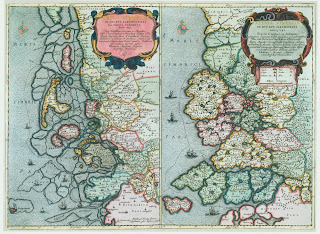What moves us?
Our reasons for moving are many. A sense of adventure, fleeing the law, a divorce, a marriage, the hope of a new beginning, our ancestors reasons for moving are varied.In tracking the Van Huss family tree, I have discovered that the progenitor, Jan Franz Van Husum and his wife Volkje left North Friesland because of the terrible flood of 1632, a flood that killed tens of thousands, and destroyed the island of Nordstrand where Volkjie lived with her sister and parents. Jan was a sea-going man who lived in the nearby port of Husum.
Eventually, the two made their way to Amsterdam, and in 1642, sailed on a ship to New Holland, and up the Hudson to the area that would one day encompass the city of Albany. Generations lived in New York, then made their way to Pennsylvania, lured by the promise of land, and from there to North Carolina and Virginia, again lured by the promise of new land.
One Valentine Felty Van Huss crossed the Appalachian Mountains and settled in Carter County, Tennessee, though at the time, it was still part of Virginia. Valentine had a son similarly named, and he had a son named Mattias. And he had a son named Valentine Worley Van Huss, raised by a much loved step mother, Lavinia Dugger.
It was this Van Huss who crossed the wide prairie with his sons and came to Kansas to eventually settle Butler County.
This post is a loose end.
Valentine Worley Van Huss
Valentine Worley Van Huss was the only child of Mathias Van Huss and Elizabeth Worley, who died giving birth. Mathias remarried and had several children with his new wife Lavina Dugger. This family lived in Elizabethton, Tennessee.
In the 1880's Valentine Worley Van Huss, his wife Lucinda and several children Tennessee for Kansas. Valentine and Lucinda and his wife Lucinda first lived near Stilwell in Johnson County, Kansas. Lucinda died there as she is buried in the Aubrey cemetery. (On Highway 69 south of Overland Park, take the 191st street exit, go east a short distance.)
VanHuss, Lucinda R,
15 Apr 1818 - 20 Oct 1870
Wife of V W VanHuss,
Old Sec, Row 12
Aubrey Cemetery.
Valentine Worley Van Huss moved on to Butler County along with his sons. He died there in 1909 and is buried in Little Walnut Glencoe Cemetery next to his son Isaac.
 |
| son Isaac and father Valentine Worley Van Huss, Little Walnut Glencoe Cemetery |













.jpg)
